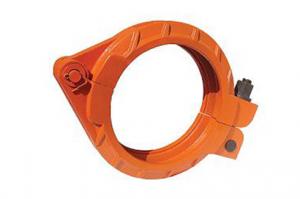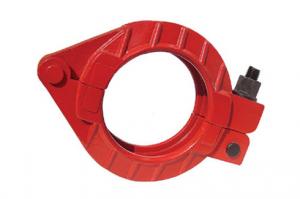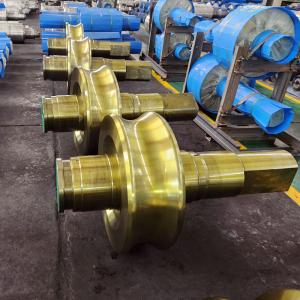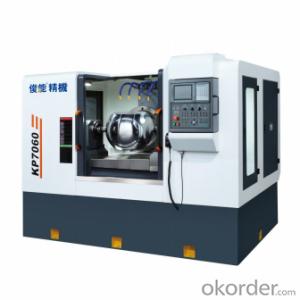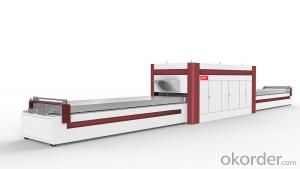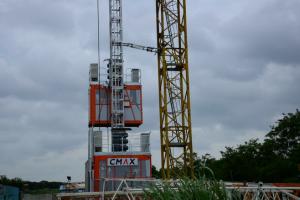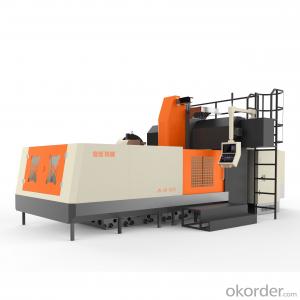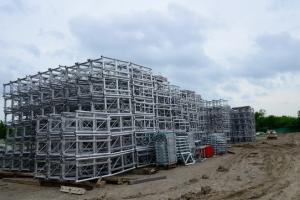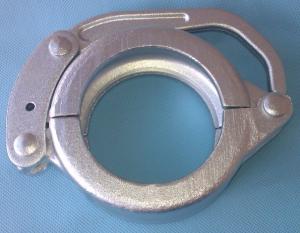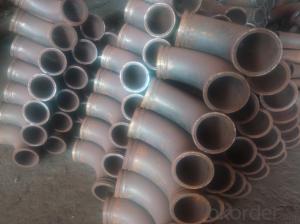Concrete Pump Parts Pipeline Coupling
- Loading Port:
- China Main Port
- Payment Terms:
- TT OR LC
- Min Order Qty:
- -
- Supply Capability:
- -
OKorder Service Pledge
Quality Product, Order Online Tracking, Timely Delivery
OKorder Financial Service
Credit Rating, Credit Services, Credit Purchasing
You Might Also Like
Size: 2"-8" (DN50-DN200)
Brand: Putzmeister, Schwing, Sany
Series: Screw Coupling, Bolt Coupling, SnapCoupling
Other products:
1) Putzmeister/ Schwing/ Zoomlion/ SermacRam Pistons
2) Putzmeister/ IHI/ Kyokuto/ Zoomlion/ SanySeperated Piston
3) Wear-resisting board and Cuts ink
4) Rubber hose
5) ST52 steel pipe, elbow, reducer
6) Cleaning seriesand others
- Q:What is the function of a concrete pump control lever?
- The function of a concrete pump control lever is to control the flow and direction of the concrete being pumped. It allows the operator to start and stop the pump, adjust the speed of the pump, and control the placement and placement speed of the concrete. The control lever also enables the operator to switch between different pumping modes, such as pumping vertically or horizontally, and adjust the pressure of the concrete being pumped. Overall, the control lever is essential in ensuring accurate and efficient concrete pumping operations.
- Q:Can I get spare parts for concrete pump hydraulic systems?
- Yes, spare parts for concrete pump hydraulic systems are typically available. You can contact the manufacturer or authorized dealers to inquire about the specific spare parts you need for your concrete pump hydraulic system.
- Q:How often should concrete pump clamps be inspected and replaced?
- To maintain proper functioning and detect any wear or damage, it is crucial to conduct regular inspections of concrete pump clamps. The inspection frequency will depend on factors like usage frequency, concrete type, and working conditions. As a general rule, it is advisable to inspect the clamps at least once a month or after every 100 hours of operation, whichever occurs first. This proactive approach will help identify any potential problems early on, preventing them from escalating into major issues. Furthermore, it is essential to visually examine the clamps before each use for any visible signs of damage or wear. This includes checking for cracks, deformations, and loose or missing bolts. The lifespan of concrete pump clamps can vary depending on factors such as clamp quality, intensity of use, and maintenance practices. However, as a general guideline, it is recommended to replace the clamps every 1-2 years or sooner if significant wear or damage is evident. Regular inspections and timely replacements of concrete pump clamps are crucial for ensuring safe and efficient pumping operations. Taking a proactive approach and promptly addressing any potential issues is always preferable to avoid costly repairs or accidents.
- Q:What are the different types of concrete pump hopper screens?
- There are several different types of concrete pump hopper screens available, each designed to meet specific needs and requirements. 1. Wire Mesh Screen: This is the most common type of hopper screen used in concrete pumps. It is made of woven wire mesh and helps to prevent large debris or aggregates from entering the pump system. Wire mesh screens are available in various sizes and can be easily replaced when worn or damaged. 2. Perforated Plate Screen: These screens are made of a solid metal plate with small holes or perforations. They are especially useful for preventing fine particles or sediments from entering the pump system. Perforated plate screens are more durable than wire mesh screens and can withstand heavy-duty applications. 3. Polyurethane Screen: These screens are made of polyurethane material, which offers excellent resistance to abrasion and wear. Polyurethane screens are commonly used in high-performance concrete pumps that handle abrasive materials. They are highly durable and can be easily cleaned or replaced when necessary. 4. Vibrating Screen: Some concrete pump hoppers are equipped with a vibrating screen, which helps to separate and remove any solids or debris from the concrete mixture. The vibrating screen uses vibration to facilitate the separation process, ensuring a cleaner and more consistent concrete flow. 5. Self-Cleaning Screen: This type of hopper screen is designed with a self-cleaning mechanism that helps to prevent clogging and maintain an uninterrupted concrete flow. Self-cleaning screens are typically made of wire mesh or perforated plate, and they use mechanical or pneumatic methods to remove debris from the screen surface automatically. It's important to choose the right type of hopper screen based on the specific requirements of your concrete pumping operation. Factors such as the size of aggregates, the presence of fine particles, and the level of abrasiveness should be considered when selecting a hopper screen to ensure optimal performance and longevity.
- Q:How often should concrete pump lubrication systems be inspected and maintained?
- Concrete pump lubrication systems should be inspected and maintained regularly, ideally on a monthly basis.
- Q:Are there any specific training or certifications required for handling and installing concrete pump spare parts?
- Handling and installing concrete pump spare parts necessitates specific training and certifications. Given the specialized nature of the equipment and the potential risks involved, individuals must undergo appropriate training and obtain relevant certifications. One must first acquire a comprehensive understanding of concrete pumps' functioning and components. This knowledge can be gained through extensive training programs offered by equipment manufacturers, industry associations, and vocational schools. These programs cover topics such as pump operation, maintenance, troubleshooting, and safety protocols. Furthermore, depending on jurisdiction or industry standards, specific certifications may be necessary. For instance, the American Concrete Pumping Association (ACPA) provides the ACPA Operator Certification, which requires individuals to demonstrate their proficiency in concrete pumping equipment, including the handling and installation of spare parts. Obtaining these certifications ensures that individuals possess the necessary knowledge and skills to handle and install concrete pump spare parts safely and efficiently. It also aids in complying with industry regulations and standards. It is crucial to note that the specific training and certification requirements may vary based on the region, industry, and type of concrete pump utilized. Therefore, it is advisable to consult local regulations and industry guidelines to ensure adherence to the requisite training and certification requirements for handling and installing concrete pump spare parts.
- Q:How do concrete pump spare parts contribute to the overall performance of the pump?
- Concrete pump spare parts play a crucial role in maintaining the overall performance of the pump. These spare parts, such as pipes, hoses, valves, and wear plates, ensure the smooth functioning of the pump by minimizing downtime and improving efficiency. They help in maintaining a consistent flow of concrete, preventing clogs and leaks, and enhancing the accuracy of the pumping process. Regular maintenance and replacement of these spare parts not only extend the lifespan of the pump but also contribute to its reliable and optimal performance, ultimately leading to increased productivity and customer satisfaction.
- Q:How do I properly maintain and replace hydraulic pumps in concrete pump spare parts?
- To ensure the smooth functioning and long life of your equipment, it is crucial to properly maintain and replace hydraulic pumps in concrete pump spare parts. Here are some steps that can assist you in this process: 1. Conduct Regular Inspections: Before and after each use, visually inspect the hydraulic pump to detect any signs of wear, leaks, or damage. Additionally, check for loose bolts, damaged seals, or excessive noise during operation. 2. Adhere to Manufacturer's Guidelines: Consult the manufacturer's guidelines and recommendations regarding the maintenance and replacement of hydraulic pumps. They will provide specific instructions concerning the frequency of maintenance, lubrication, and replacement intervals. 3. Ensure Proper Lubrication: Smooth operation of hydraulic pumps requires proper lubrication. Regularly check the oil levels and refill if necessary. Utilize the recommended oil or hydraulic fluid as specified by the manufacturer. Adhere to the guidelines regarding the frequency of oil changes. 4. Maintain Regular Cleaning: Keep the hydraulic pump and its components free from debris, dust, and dirt. Employ a clean cloth or compressed air to eliminate any accumulated contaminants. This practice will help prevent damage and minimize the likelihood of clogs or blockages. 5. Replace Worn Parts: Over time, certain components of the hydraulic pump may wear out and necessitate replacement. Maintain a stock of spare parts, including seals, gaskets, and filters, to promptly replace any worn or damaged components. 6. Seek Professional Assistance: If you are uncertain about any aspect of maintaining or replacing hydraulic pumps, it is advisable to consult a professional technician or the manufacturer. They possess the expertise and knowledge to guide you through the process and ensure the best maintenance and replacement practices. Remember, regular maintenance and timely replacement of hydraulic pumps in concrete pump spare parts will not only prolong the lifespan of your equipment but also ensure safe and efficient operation on construction sites.
- Q:How long does it take to replace a specific concrete pump spare part?
- The duration required to replace a specific spare part for a concrete pump can vary based on several factors. Initially, the replacement time will be influenced by the complexity and size of the part. Smaller and simpler parts can be swapped out relatively quickly, whereas larger and more intricate components may necessitate a lengthier process. Additionally, the availability of the spare part is a crucial consideration. If the part is readily accessible and in stock, the replacement procedure can be expedited. Conversely, if the part must be ordered or obtained from a supplier, there may be a delay in receiving it, thereby extending the overall replacement time. Moreover, the competence and experience of the individual or team carrying out the replacement will also impact the duration. Trained and skilled professionals are likely to complete the replacement more efficiently compared to those with limited knowledge or experience. Lastly, unforeseen complications or issues that arise during the replacement process can also affect the time required. It is possible that additional repairs or adjustments may be necessary, which could further prolong the replacement time. In conclusion, the duration for replacing a specific spare part for a concrete pump is dependent on the part's complexity and size, its availability, the expertise of the individuals performing the replacement, and any unforeseen complications that may arise. Therefore, it is challenging to provide an exact timeframe without taking these factors into consideration.
- Q:What is the function of a concrete pump remote control antenna?
- The primary role of a concrete pump remote control antenna is to establish a wireless connection between the remote control device and the concrete pump. This connection enables the operator to remotely manage various functions of the concrete pump, including initiating and terminating the pump, adjusting concrete speed and flow, and controlling boom movements. The antenna receives signals transmitted by the remote control device and transmits them to the concrete pump, enabling the operator to safely control the pump from a distance. By providing the operator with improved visibility of the pump and its surroundings, while maintaining complete operational control, this technology contributes to enhanced efficiency, accuracy, and safety at construction sites.
1. Manufacturer Overview |
|
|---|---|
| Location | |
| Year Established | |
| Annual Output Value | |
| Main Markets | |
| Company Certifications | |
2. Manufacturer Certificates |
|
|---|---|
| a) Certification Name | |
| Range | |
| Reference | |
| Validity Period | |
3. Manufacturer Capability |
|
|---|---|
| a)Trade Capacity | |
| Nearest Port | |
| Export Percentage | |
| No.of Employees in Trade Department | |
| Language Spoken: | |
| b)Factory Information | |
| Factory Size: | |
| No. of Production Lines | |
| Contract Manufacturing | |
| Product Price Range | |
Send your message to us
Concrete Pump Parts Pipeline Coupling
- Loading Port:
- China Main Port
- Payment Terms:
- TT OR LC
- Min Order Qty:
- -
- Supply Capability:
- -
OKorder Service Pledge
Quality Product, Order Online Tracking, Timely Delivery
OKorder Financial Service
Credit Rating, Credit Services, Credit Purchasing
Similar products
New products
Hot products
Related keywords


